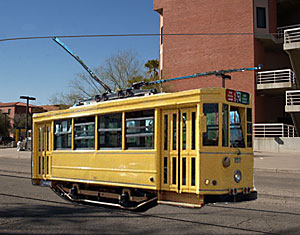 |
|
PHOTO ILLUSTRATION BY DAVID HARDEN/Arizona Daily Wildcat
|
Tucson transit could have a new look around the university area if a UA/City of Tucson proposal is passed, making a new route for the Old Pueblo Trolley. The route would connect downtown Tucson with the UA campus, starting at Rio Nuevo and ending at North Cherry Avenue and East Speedway Boulevard.
|
|
|
By Aaron Mackey
Arizona Daily Wildcat
Tuesday, March 9, 2004
Print this
Will extend to UMC via Park Ave., Second St.
In addition to bikes, CatTrans and pedestrians on cell phones, students may also have to dodge trolleys in order to get to classes in the Harvill building.
Under a proposal being entertained by the city, Old Pueblo Trolley, which currently runs from North University Boulevard down to East Fourth Avenue, would expand its services to link downtown Tucson to the Arizona Health Sciences Center.
One proposed route would bring the trolley down East Second Street, passing the Slonaker House and the Harvill building.
While no plan has been solidified and no funding set aside for the project, the city of Tucson and the UA are collaborating on the proposal, said Shellie Ginn, bicycle and pedestrian coordinator for the city of Tucson.
The expansion would link the Rio Nuevo downtown revitalization project with the UA, Ginn said.
Richard Guthrie, president and chief operating officer of Old Pueblo Trolley, said the trolley would pass by the UA's main gate and head north on North Park Avenue.
The trolley would hang a right at North Park Avenue and East Second Street and head to North Cherry Avenue.
At North Cherry Avenue, the trolley would cross East Speedway Boulevard on its way toward AHSC.
Connecting downtown Tucson to the UA would allow students and visitors to easily access museums at both locations, while providing a boost to businesses that line the route, Guthrie, a UA alumnus, said.
By increasing the trolley's route, Ginn said she hopes people will see the project as a viable mode of transportation.
"This will make life a little more pleasant downtown," she said.
According to the 2003 Campus Master Plan, the UA is interested in creating "unique downtown housing options for students, faculty and staff."
Ginn said students and faculty could easily use the trolley to travel to and from the UA.
But the expansion would be difficult for Old Pueblo Trolley to afford, as it is a non-profit organization that uses volunteers to operate the trolleys, Guthrie said.
The trolley service operates only on the weekends, but if the route were expanded, Guthrie said the trolley would run seven days per week.
The trolley would also operate refurbished or replica streetcars that require extra money to maintain.
In order to accommodate the changes, the trolley service would have to hire staff and add two trolleys to the four that are already in operation.
Right now, a one-way trolley ticket costs $1 for adults and 50 cents for children
According to Old Pueblo Trolley's Web site, it would cost $8 million to put in new rails, wiring and electricity. The money would also go toward buying and servicing the streetcars, which would cost about $300,000 per year.
Guthrie said he wants the city to subsidize the project in order to expand the trolley's services while keeping prices reasonable.
Programs such as SunTran and ParkWise receive money from the city.
Fares would be similar to that of SunTran, Guthrie said.
Old Pueblo Trolley is negotiating a contract with the city to set up the subsidiary, Guthrie said.
With the proper funds, Guthrie said a staff could manage the service during the week and allow volunteers to work on the weekends.
If the trolley's expansion does become a reality, both Guthrie and Ginn said the trolley could become a successful alternative to traveling downtown and to the UA.
Guthrie said the success would provide a good example of mass transit that could convince voters to support a light rail system.
In November, Tucsonans voted against a proposed light rail system that would have been created around East Broadway Boulevard.
But Ginn said a great deal of research would have to be done to look into whether a light rail system would be feasible.
Ginn added that it might be more realistic to expand the trolley service, which uses refurbished streetcars, rather than using light rail passenger cars.
Guthrie said that the trolley would be successful, because people would enjoy riding the trolley.
"Rail transportation like Old Pueblo Trolley is more subject to use by all customers than a bus," he said.
In 2003, nearly 23,000 people rode the trolley, Guthrie said.
